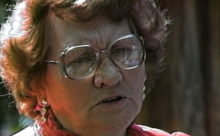Interview with the filmmaker Cece Conway
Zoe van Buren, Interviewer
ZOE VAN BUREN: How did you get involved with the movie project?
CECE CONWAY: My first memory of meeting Bessie was that Patricia had met her already, and she was going to sing at the Eno Festival, so they came down to spend the night with me. We all went to the festival, and Bessie sang with her granddaughter. She had a pretty red dress, and I believe a lot of that footage ended up in the film, and was some of the really good footage. That was a really festive and interesting time together.
The first time we shot in Boone was a church service that she invited us to, and so both Patricia and Elva and I were all there for that. The church footage meant a lot to Bessie, to be in the movie. Elva and I did a rough edit of some of that which we ended up not using in the movie, but it’s somewhere if anyone’s interested, this small 25 or 30 minute edit of that particular church service.
The other filming we did, primarily, was the session at her house that was really important, where all three of us were there. Her little grandson was there, and one of the interesting things was that she began telling him the Three Little Pigs, beginning to teach him how to do it. That was a special opportunity that came up. The film really became more about Bessie than about her repertoire, because she just had a lot of vivacity.
Another important section was when we took Bessie to the Appalachian State University campus to some of my classes, and we tried to make the lounge look a little more comfortable, I think we hung a quilt behind her. She had a nice relationship with the students, and that was an interesting part. One of the most important things was that in one of those classes, she began talking about difficulties in her marriage. I don’t know how much she had done that before, but Patricia had kind of tip-toed around it, and Elva and I were really saying, “Oh, my goodness, say more.” And she did. I think that really was very important material, and important to her to be able to tell us about that, and how difficult and scary parts of her marriage had been. As a girl she had sometimes had to be on the lookout when her father was moonshining. But with the husband, her sister was going to marry his brother or somebody, and she really kind of agreed to marry him so her sister wouldn’t be alone with this other person. So the two of them were married to these relatives, and that led her into this difficult marriage. With the business about the horse threatening the child, and her not standing for that, and then the business about dealing with the flood, she was really an amazing and courageous person, and was really aware of what she’d had to deal with. And then there was another follow-up part of that. When we recorded this it was at her house, and it was in the evening, and there were maybe two or three of us there. She began to talk about the light coming after her husband had died, and it was sort of like his revisiting, and then it was finally over. So it was just very interesting to get to know her some.
ZOE VAN BUREN: What drew you to the project, or to Mrs. Eldreth as a person?
CECE CONWAY: I think that first visit really did it. It was fun to have the two of them visit, and Bessie had a good sense of humor. She was very interested that her granddaughter was getting interested in some of the music, and her granddaughter was very personable too. Bessie just enjoyed being at the festival. And she was a great cook! I think some of the cooking scenes were significant and fun. And It’s amazing how thorough and detailed Patricia’s analysis of all it was.
It was fun contributing to materials for her to get the NC Heritage Award. The video made it much easier for her to do that. It became apparent that that was an important thing to do for Bessie, and the film made it easy to present material.
ZOE VAN BUREN: How did the storytelling process come together?
CECE CONWAY: Most films for video are about 26 minutes long, and this may be a little bit longer than that. So I think from the beginning we knew that that needed to be the size of what we were dealing with. It was just that those seemed to be the highlights of what actually happened. They were things that struck us early and remained important. How to fit it all together is always an issue too. A text and a film are really different creatures.
ZOE VAN BUREN: How do you use the film in your classes?
CECE CONWAY: I teach an advanced folklore class. We have a lot of music, and visitors who are great tradition bearers, but if we don’t have a visitor I’ll show a video for more variety. A lot of these people are dead, and it’s a chance to let them re-experience what a lot of us got to experience that was incredible, and can’t really be replaced. I want the students to have a sense of the traditions bearers, because there’s just a sense of wisdom there, and expertise and experience. That’s largely how I’ve tried to use the films, as well as to show different genres and performances. And as well as the Gees Bend quilting video, I show this one because it’s about women’s experiences. What’s that saying? “If one woman will tell the truth, the world will change?”
